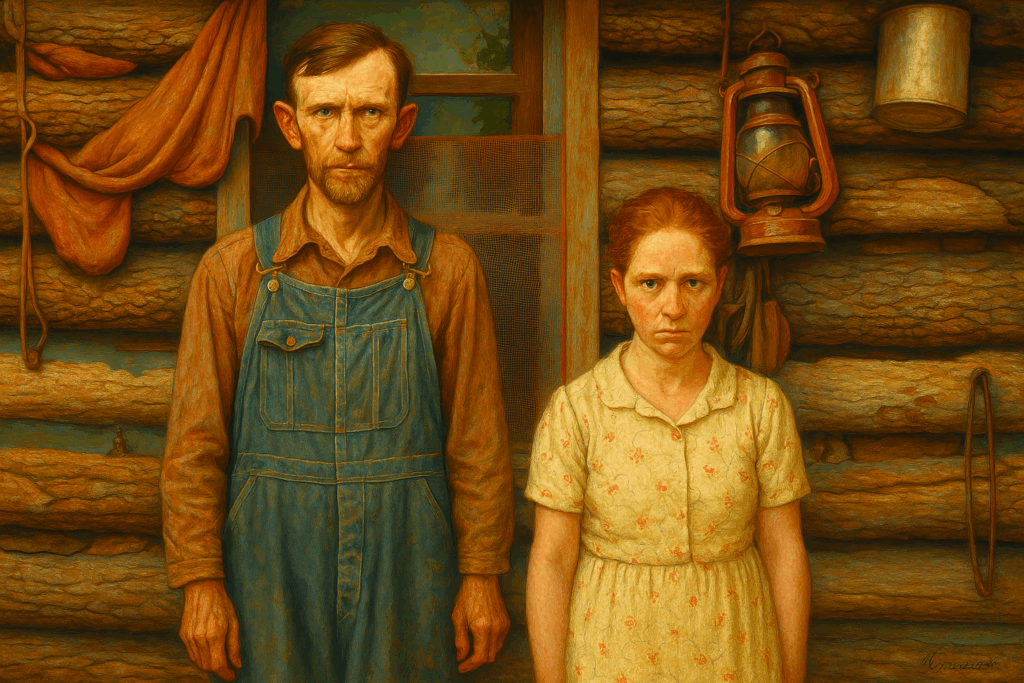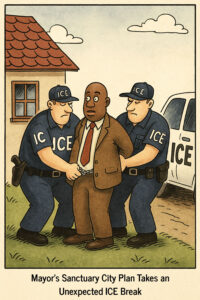 They stare out from the past, unsmiling and unbowed. A man in worn denim overalls and a woman in a faded floral dress, standing shoulder to shoulder in front of a log wall patched with the tools and tokens of survival—lantern, rope, bucket, cloth. They aren’t asking for anything. They’re just letting you look.
They stare out from the past, unsmiling and unbowed. A man in worn denim overalls and a woman in a faded floral dress, standing shoulder to shoulder in front of a log wall patched with the tools and tokens of survival—lantern, rope, bucket, cloth. They aren’t asking for anything. They’re just letting you look.
This image reimagines Ben Shahn’s 1935 photograph of “rehabilitation clients” from Boone County, Arkansas—tenant farmers living through the worst of the Great Depression. It’s rendered in the style of Norman Rockwell, not to sweeten the hardship, but to make sure we don’t look away from it.
It would’ve been easy to lose the soul in that translation—to let soft brushstrokes blur the sharp truth of poverty. But this version doesn’t blink. The lines etched into the man’s face, the pale strain in the woman’s eyes, the plain clothes, the set of their shoulders—it all still reads clear as a cotton ledger. There’s no sentimentality here, no cozy idealism. Just the hard dignity of people who worked a patch of earth that barely worked back.
I know people like this. You probably do too. Maybe they’re your grandparents, maybe they’re neighbors. Maybe they’re you. There’s something familiar in the way these two stand—defiant not in posture, but in the simple fact that they are still standing.
The original photo came from the Resettlement Administration, part of the federal government’s attempt to hold rural America together during a time of collapse. The people in it were labeled “rehabilitation clients”—a bureaucratic term for those still trying to make something grow after the economy left them for dead. Sounds familiar, doesn’t it?
Tenant farming never really ended. It just changed names. Today it’s contract labor, sharecropping by another word, or debt service disguised as opportunity. And the same weary eyes are still out there—only now they’re scanning gas pumps, hospital bills, or the fine print on a farm loan.
So when someone tells us they want to “Make America Great Again,” it’s worth asking: Is this the “Again?” Is this what they want us to return to—barefoot dignity, back-breaking work, and a government that watches you toil and calls it a success story?
What makes this image powerful isn’t just its style. It’s that it tells a story rarely painted: the unflinching truth of working-class hardship, without the wink. It gives color to a history that’s often remembered in grayscale, and in doing so, insists we look again.
Because sometimes, in order to see how heavy the weight of cotton really was—and still is—you’ve got to bring the past into full color.
Based on the October 1935 photograph by Ben Shahn for the United States Resettlement Administration, this modern reinterpretation captures the same unflinching realism—now reimagined in painterly tones. A man and woman stand before their log home, unsmiling and unmoved, their posture as stark as the times. The original subjects were labeled simply as “rehabilitation clients,” a bureaucratic phrase that barely contains the grit and gravity of their presence.
Their clothes are worn but not ragged. Their eyes do not plead. There is no shame here, only the honesty of rural poverty—and the dignity that endures when everything else is spare.
Adapted from the original FSA/OWI file LC-USF33-006034-M2. Photograph by Ben Shahn, Boone County, Arkansas, October 1935.
AI-generated reinterpretation in the style of Norman Rockwell, drawn from public domain archival reference.
The Past, Reimagined Like Rockwell #9
Is this the “Again?” #3

